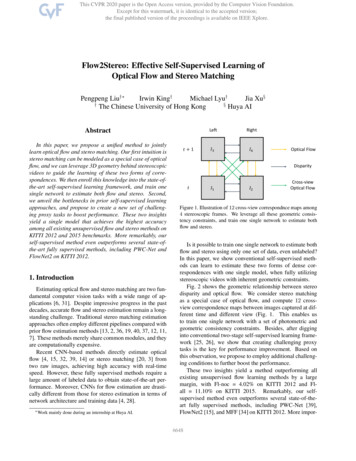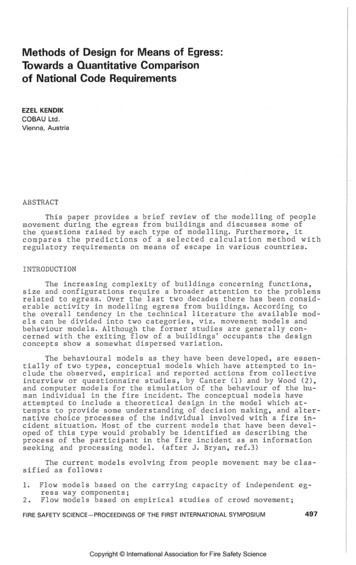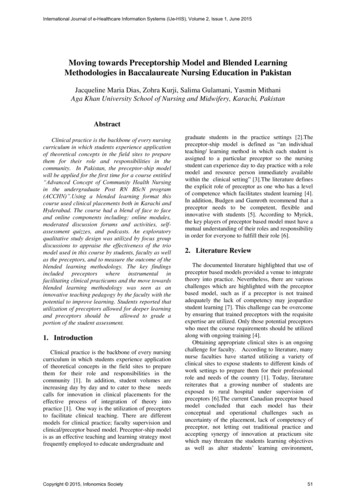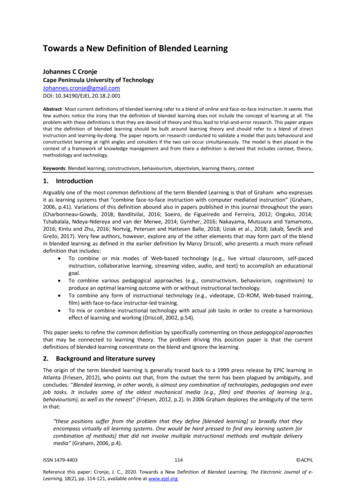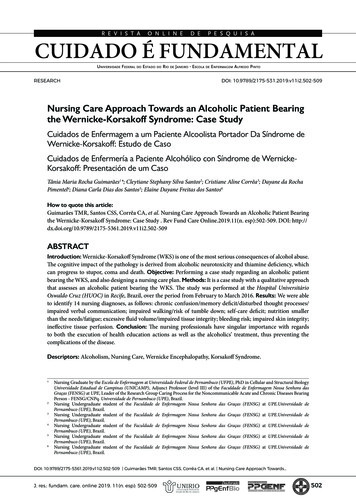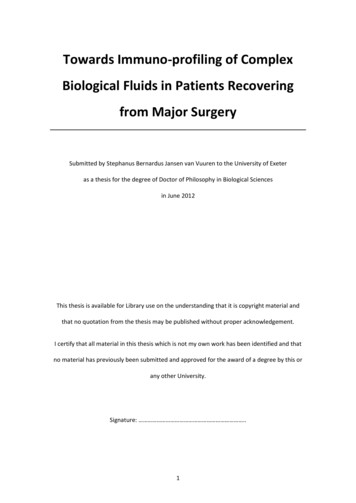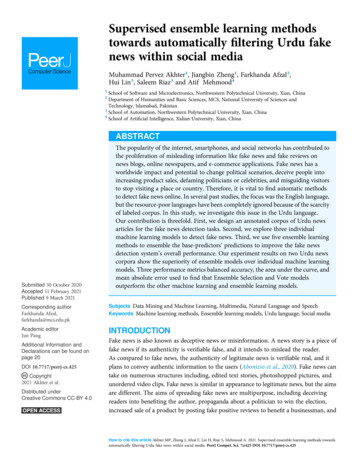
Transcription
Supervised ensemble learning methodstowards automatically filtering Urdu fakenews within social mediaMuhammad Pervez Akhter1, Jiangbin Zheng1, Farkhanda Afzal2,Hui Lin3, Saleem Riaz3 and Atif Mehmood41School of Software and Microelectronics, Northwestern Polytechnical University, Xian, ChinaDepartment of Humanities and Basic Sciences, MCS, National University of Sciences andTechnology, Islamabad, Pakistan3School of Automation, Northwestern Polytechnical University, Xian, China4School of Artificial Intelligence, Xidian University, Xian, China2ABSTRACTSubmitted 30 October 2020Accepted 11 February 2021Published 9 March 2021The popularity of the internet, smartphones, and social networks has contributed tothe proliferation of misleading information like fake news and fake reviews onnews blogs, online newspapers, and e-commerce applications. Fake news has aworldwide impact and potential to change political scenarios, deceive people intoincreasing product sales, defaming politicians or celebrities, and misguiding visitorsto stop visiting a place or country. Therefore, it is vital to find automatic methodsto detect fake news online. In several past studies, the focus was the English language,but the resource-poor languages have been completely ignored because of the scarcityof labeled corpus. In this study, we investigate this issue in the Urdu language.Our contribution is threefold. First, we design an annotated corpus of Urdu newsarticles for the fake news detection tasks. Second, we explore three individualmachine learning models to detect fake news. Third, we use five ensemble learningmethods to ensemble the base-predictors’ predictions to improve the fake newsdetection system’s overall performance. Our experiment results on two Urdu newscorpora show the superiority of ensemble models over individual machine learningmodels. Three performance metrics balanced accuracy, the area under the curve, andmean absolute error used to find that Ensemble Selection and Vote modelsoutperform the other machine learning and ensemble learning models.Corresponding authorFarkhanda Afzal,farkhanda@mcs.edu.pkSubjects Data Mining and Machine Learning, Multimedia, Natural Language and SpeechKeywords Machine learning methods, Ensemble learning models, Urdu language, Social mediaAcademic editorJun PangINTRODUCTIONAdditional Information andDeclarations can be found onpage 20DOI 10.7717/peerj-cs.425Copyright2021 Akhter et al.Distributed underCreative Commons CC-BY 4.0Fake news is also known as deceptive news or misinformation. A news story is a piece offake news if its authenticity is verifiable false, and it intends to mislead the reader.As compared to fake news, the authenticity of legitimate news is verifiable real, and itplans to convey authentic information to the users (Abonizio et al., 2020). Fake news cantake on numerous structures including, edited text stories, photoshopped pictures, andunordered video clips. Fake news is similar in appearance to legitimate news, but the aimsare different. The aims of spreading fake news are multipurpose, including deceivingreaders into benefiting the author, propaganda about a politician to win the election,increased sale of a product by posting fake positive reviews to benefit a businessman, andHow to cite this article Akhter MP, Zheng J, Afzal F, Lin H, Riaz S, Mehmood A. 2021. Supervised ensemble learning methods towardsautomatically filtering Urdu fake news within social media. PeerJ Comput. Sci. 7:e425 DOI 10.7717/peerj-cs.425
defame a showbiz star (Monteiro et al., 2018). There are numerous hazardous impactson our society of the proliferation of fake news. Fake news changes the manner of theindividual to interpret and reply to legitimate news. Besides, fake news makes individualsskeptical by destroying consumers’ trust in the media by posting fabricated and biasednews stories (Agarwal & Dixit, 2020).Spreading fake news is not a new problem in our time. Before the advent of the internet,fake news was transmitted through face-to-face (oral), radio, newspaper, and television.In recent years with the advent of the computer, the internet, smartphones, websites,news blogs, and social media applications have contributed to transmitting fake news.There are several reasons for spreading fake news through the internet and social media.It requires less cost and time than traditional news media. It is very easy to manipulatelegitimate digital news and share the fabricated news story rapidly. Since 2017, there hasbeen a 13% global increase in social media users (Kaur, Kumar & Kumaraguru, 2020).Fake news influences different groups of people, products, companies, politicians, showbiz,news agencies, and businessman.It requires more energy, cost, and time to manually identify and remove fake news orfake reviews from social media. Some previous studies conclude that humans performpoorly than automated systems to separate legitimate news from fake news (Monteiroet al., 2018). For the last few years, machine learning methods’ focus is to differentiatebetween fake and legitimate news automatically. After the U.S. presidential elections in2015, few popular social media applications like Twitter, Facebook, and Google started topay attention to design machine learning and natural language processing (NLP) basedmechanisms to detect and combat fake news. The remarkable development of supervisedmachine learning models paved the way for designing expert systems to identify fakenews for English, Portuguese (Monteiro et al., 2018; Silva et al., 2020), Spanish(Posadas-Durán et al., 2019), Indonesian (Al-Ash et al., 2019), German, Latin, andSlavic languages (Faustini & Covões, 2020). A major problem of machine learning modelsis that different models perform differently on the same corpus. Their performance issensitive to corpus properties like corpus size, distribution of instances into classes(Pham et al., 2021). For example, the performance of K-nearest neighbor (KNN) dependson the number of nearest points (k) in the dataset. Support Vector Machine (SVM)suffers from numerical instability when solving optimization problems (Xiao, 2019).Similarly, the performance of an artificial neural network is prone to optimal architectureand tuning its parameters (Pham et al., 2021).Ensemble learning is considered an efficient technique that can boost the efficiency ofindividual machine learning models, also called base-models, base-predictors, or baselearners, by aggregating the predictions of these models in some way (Lee et al., 2020).Ensemble learning aims to exploit the diversity of base-predictors to handle multiple typesof errors to increase overall performance. Ensemble learning techniques show superiorperformance in various recent studies about fake news detection. In a recent study, theensemble learning technique outperformed the four deep learning models including thedeep structured semantic model with RNN, intentCapsNet, LSTM model, and capsuleneural network (Hakak et al., 2021). In another recent study, Mahabub (2020) appliedAkhter et al. (2021), PeerJ Comput. Sci., DOI 10.7717/peerj-cs.4252/24
eleven machine learning classifiers including the neural network-based model MLP on afake news detection corpus. After that, three out of eleven machine models were selected toensemble a voting model. Ensemble voting with soft voting outperformed the othermodels. Gutierrez-Espinoza et al. (2020) applied two ensemble methods bagging andboosting with SVM and MLP base-predictors to detect fake reviews detection. Experimentsshow that boosting with MLP outperforms the other.This can be achieved in numerous ways, including homogenous models with diverseparameters, heterogeneous models, resampling the training corpus, or using differentmethods to combine predictions of base-predictors (Gupta & Rani, 2020). Ensemblelearning can be of two types: parallel and sequential. In the parallel ensemble, basepredictors are trained independently in parallel. In the sequential ensemble, basepredictors are trained sequentially, where a model attempts to correct its predecessor(Pham et al., 2021). Ensemble learning methods have shown good performance in variousapplications, including solar irradiance prediction (Lee et al., 2020), slope stability analysis(Pham et al., 2021), natural language processing (Sangamnerkar et al., 2020), malwaredetection (Gupta & Rani, 2020), traffic incident detection (Xiao, 2019). In the past,several studies explored machine learning models for fake news detection task in a fewlanguages like Portuguese (Monteiro et al., 2018; Silva et al., 2020), Spanish (PosadasDurán et al., 2019; Abonizio et al., 2020), Urdu (Amjad et al., 2020; Amjad, Sidorov &Zhila, 2020), Arabic (Alkhair et al., 2019), Slavic (Faustini & Covões, 2020; Kapusta &Obonya, 2020), and English (Kaur, Kumar & Kumaraguru, 2020; Ozbay & Alatas, 2020).As compared to machine learning, a few efforts have been made to explore ensemblelearning for fake news detection like Indonesian (Al-Ash & Wibowo, 2018; Al-Ash et al.,2019), English (Kaur, Kumar & Kumaraguru, 2020; Sangamnerkar et al., 2020).Therefore, this study aims to investigate ensemble learning methods for the fake newsdetection task.Urdu is the national language of Pakistan and the 8th most spoken language globally,with more than 100 million speakers (Akhter et al., 2020a). Urdu is the South Asianseverely resource-poor language. As compared to resource-rich languages like English, afew annotated corpus from very few domains are available for research purposes. Besides,insufficient linguistic resources like stemmers and annotated corpora make the researchmore challenging and inspired. Particularly in Urdu, studying fake news detection hasseveral challenges. First, unavailability of some sufficient annotated corpus. A recent study(Amjad et al., 2020) proposed an annotated fake news corpus with a few hundred newsarticles. Experiments on this corpus reveal the poor performance of machine learningmodels. Second, labeling a news article as “fake” or “legitimate” needs experts’ opinions,which is time taking. Last, hiring experts in the relevant domains is an expensive task.Therefore, in this study, we design a machine-translated corpus of Urdu news articlestranslated from English news articles using Google Translate. We followed the sameprocedure in the study (Amjad, Sidorov & Zhila, 2020). Experiments reveal that machinelearning models do not perform well on machine-translated corpus compared to the realdataset (Amjad, Sidorov & Zhila, 2020). Because of the small size, the corpus is notsufficient to make any conclusion about machine learning models’ performance.Akhter et al. (2021), PeerJ Comput. Sci., DOI 10.7717/peerj-cs.4253/24
Further, to the best of our knowledge, no study explores ensemble learning models forUrdu fake news detection tasks.Inspired by the work done in other languages, we are investigating the issue of fakenews detection in the Urdu language. The major aim of this study is to explore thecapability of ensemble learning models in improving fake news predictions in resourcepoor language Urdu. Our significant contributions to this study have been summarizedbelow: We manually built an annotated news corpus composed of Urdu news articlesdistributed into legitimate and fake categories. We perform several experiments using three diverse traditional machine learningclassifiers Naïve Bayes (NB), Decision Tree (DT), and SVM, and five ensemble models,including Stacking, Voting, Grading, Cascade Generalization, and Ensemble Selection,to achieve improved prediction quality relative to conventional individual machinelearning models. We investigate the performance of our models using three feature sets generatedthrough character-level, word-level, and statistical-based feature selection methods. We report experiments of both machine learning and ensemble learning models on twofake news corpora of the Urdu language. We comparatively analyze the performance of our models using four performancemeasures, including balanced accuracy, the area under the curve, time and meanabsolute error.Hence forward this article is organized as follows: “Related Work” presents the essentialrelated works. “Machine Learning and Ensemble Learning Models” provides a briefoverview of machine learning and ensemble learning models used in this study.“Methodology and Corpus Construction” will show the architecture of the adoptedframework and corpus characteristics. The results of the experiments are comparativelydiscussed in “Results”. Finally, “Conclusions” ends the article with conclusions and futuredirections.RELATED WORKOnline social media and instant messaging applications like Facebook, Google, andTwitter are popular these days in talking to your loved ones, expressing your opinion,sharing professional information, or posting news about the subject of interest. Further,it is common to find some information on the internet quickly. Unfortunately,all the information available on social media sites is not accurate and reliable as it isstraightforward to manipulate digital information and quickly spread it in the world.Therefore, it is vital to design some accurate, efficient, and reliable automated systems todetect fake news from a large corpus.In the past, numerous machine learning methods have been used to combat fakenews. Monteiro et al. (2018) showed that the multi-layer perceptron (MLP) modeloutperforms the NB and random forest to identify fake news from a large news corpus.Akhter et al. (2021), PeerJ Comput. Sci., DOI 10.7717/peerj-cs.4254/24
The study of Faustini & Covões (2020) concludes that SVM with bag-of-word (BoW)feature outperformed the other on five corpora of three languages Germanic, Latin, andSlavic. A benchmarking study for fake news detection concludes that SVM with linguisticbased word embedding features enables us to classify fake news with high accuracy(Gravanis et al., 2019). A study about Portuguese fake news detection reveals t
mechanisms to detect and combat fake news. The remarkable development of supervised machine learning models paved the way for designing expert systems to identify fake news for English, Portuguese (Monteiro et al., 2018; Silva et al., 2020), Spanish (Posadas-Durán et al., 2019), Indonesian (Al-Ash et al., 2019), German, Latin, and
